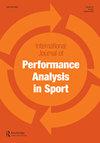Does a decade of the rally-point scoring system impact the characteristics of elite badminton matches?
IF 1.6
4区 教育学
Q2 SPORT SCIENCES
International Journal of Performance Analysis in Sport
Pub Date : 2023-10-20
DOI:10.1080/24748668.2023.2272121
引用次数: 0
Abstract
ABSTRACTThis study aimed to investigate game characteristics in men’s singles badminton matches at world championships under a decade of rally-point scoring system. Time interval has been hypothesised to affect timing factors, such as game duration, rally time, rest time, rest at point 11, and rest time between games. Overall, 56 matches (n = 127 games) were analysed using video footage. We found that year affected all variables from 2006 to 2017, except for the total points played. Consequently, game duration, rally time, rest time, rest time at point 11 and rest time between games increased by 54.0% (p = 0.002, r = 0.407), 62.2% (p = 0.000), 49.3% (p = 0.000), 44% (p < 0.001, r = 0.36) and 74.9% (p = 0.000, r = 0.50), respectively. Furthermore, we suggest that game characteristics in men’s singles badminton matches evolve towards longer rallies with longer rest time, rest time at point 11 and rest time between games, exceeding the limits of the badminton regulation. Therefore, stricter rule enforcement, the introduction of a time limit for the rest time between the rallies, which is similar to the shot clock implemented in tennis for the service execution or a change of the scoring system appears to be necessary to ensure a further reduction of the game duration.KEYWORDS: Badmintonmatch analysiselite performersworld championshipsrally-point scoring system AcknowledgementsWe thank Dominik Eiden for his support during data acquisition and Jonas Breuer during data analyses.Disclosure statementNo potential conflict of interest was reported by the author(s).Additional informationFundingThis work was supported by the Badminton World Federation (BWF) under Research Grants 2017-18.十年来的拉力赛计分系统是否影响了精英羽毛球比赛的特点?
[摘要]本研究旨在探讨在10年的记分制下羽毛球世锦赛男单比赛的比赛特点。假设时间间隔会影响时间因素,如比赛持续时间、集结时间、休息时间、11点休息时间和比赛之间的休息时间。总的来说,56场比赛(n = 127场)使用视频片段进行了分析。我们发现,从2006年到2017年,除了总得分外,年份影响了所有变量。因此,比赛持续时间、集结时间、休息时间、11点休息时间和比赛间休息时间分别增加了54.0% (p = 0.002, r = 0.407)、62.2% (p = 0.000)、49.3% (p = 0.000)、44% (p < 0.001, r = 0.36)和74.9% (p = 0.000, r = 0.50)。此外,我们认为羽毛球男单比赛的比赛特点是朝着休息时间较长的回合、11点休息时间和比赛间休息时间的方向发展,超出了羽毛球规则的限制。因此,为了确保进一步缩短比赛时间,有必要采取更严格的规则执行措施,比如为两回合之间的休息时间引入时间限制,这类似于网球中为发球执行而实施的击球时钟,或者改变计分系统。关键词:羽毛球比赛分析,精英运动员,世界锦标赛,积分计分系统感谢我们感谢Dominik Eiden在数据采集和Jonas Breuer在数据分析中的支持。披露声明作者未报告潜在的利益冲突。本研究由世界羽毛球联合会(BWF)在2017-18研究基金下支持。
本文章由计算机程序翻译,如有差异,请以英文原文为准。
求助全文
约1分钟内获得全文
求助全文
来源期刊

International Journal of Performance Analysis in Sport
Health Professions-Physical Therapy, Sports Therapy and Rehabilitation
CiteScore
4.40
自引率
4.80%
发文量
38
期刊介绍:
The International Journal of Performance Analysis in Sport aims to present current original research into sports performance. In so doing, the journal contributes to our general knowledge of sports performance making findings available to a wide audience of academics and practitioners.
 求助内容:
求助内容: 应助结果提醒方式:
应助结果提醒方式:


